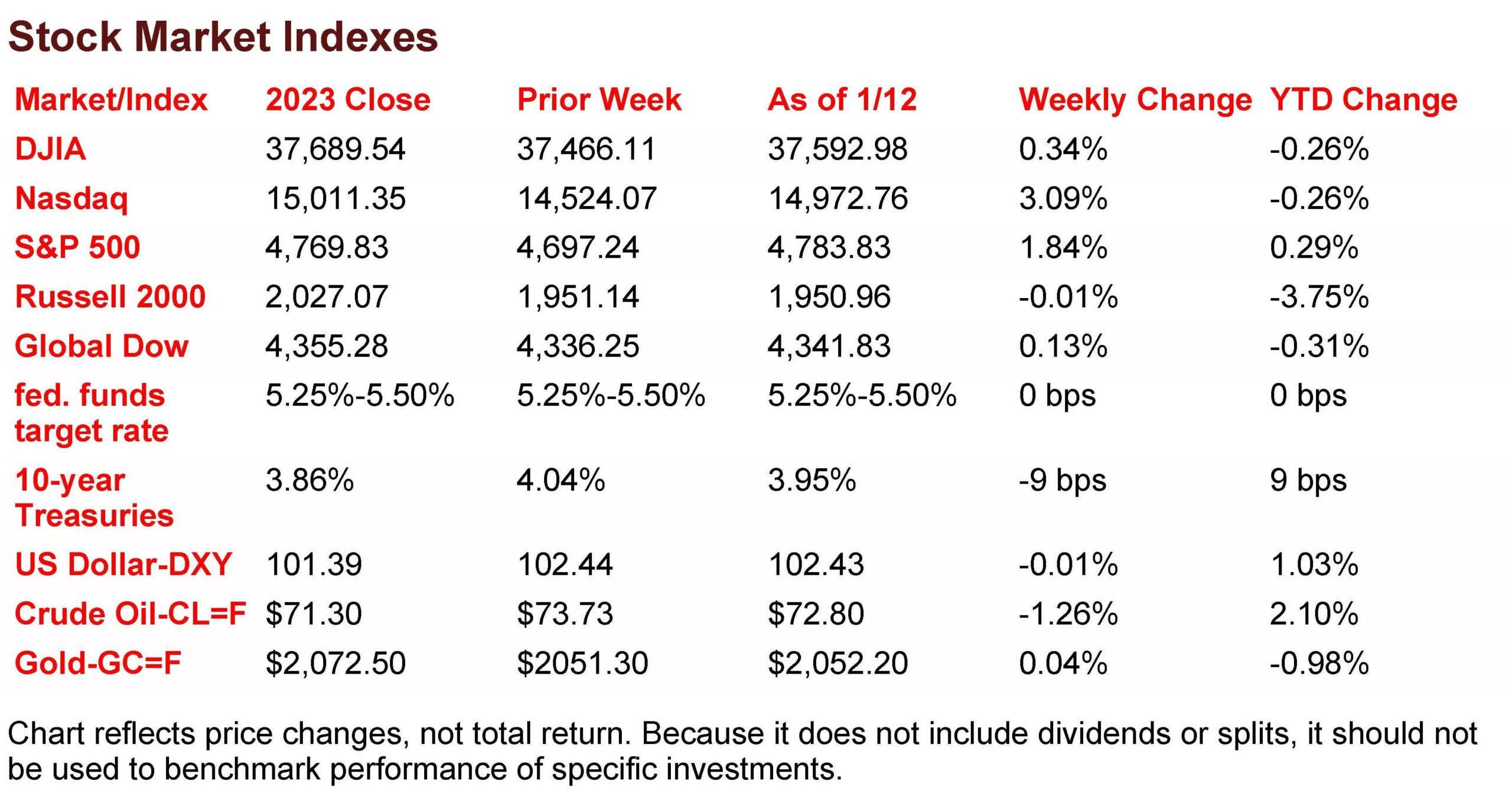Market Week: January 15, 2024
Market Recap:
Wall Street has had a positive week as benchmark indices rebounded despite the declining likelihood of an interest rate cut. The benchmark indexes rallied from a slow start to the year, with information technology and communication services leading, while energy and utilities underperformed. Major financial companies reported lower-than-expected fourth-quarter earnings. The Nasdaq saw a surge on Monday, led by tech shares, and there were positive gains across other indexes. Wednesday saw another advance, driven by surging tech shares, but on Thursday, equities took a marginal step back following news of higher-than-expected consumer prices. The week ended with mixed results across the Global Dow, S&P 500, Nasdaq, Dow, and Russell 2000, with slight variations in Treasury yields, crude oil prices, and the dollar and gold prices.
The Consumer Price Index rose 0.3% in December, dampening hopes for a Federal Reserve interest rate cut, while producer prices were lower than expected, the Treasury monthly budget deficit for December 2023 was $129.0 billion, the goods and services trade deficit decreased by $1.3 billion in November, the national average retail price for regular gasoline was $3.073 per gallon on January 8, and there were 202,000 new claims for unemployment insurance for the week ended January 6.
The Markets (as of market close January 12, 2024)
Wall Street saw stocks close higher last week, despite dampening hopes of an interest rate reduction. Each of the benchmark indexes listed here rebounded from a slow start to the year by adding value last week. Some major financial companies posted lower-than-expected fourth-quarter earnings. Information technology and communication services led the sectors, while energy and utilities underperformed. Ten-year Treasury yields slipped lower. Crude oil prices retreated marginally. The dollar was flat, while gold prices ticked higher.
Stocks closed sharply higher last Monday, led by a rally in tech shares. The Nasdaq jumped 2.2% as chip makers saw their stocks surge while megacaps outperformed. The Russell 2000 added 1.9%, followed by the S&P 500 (1.4%), the Dow (0.6%), and the Global Dow (0.3%). Ten-year Treasury yields dipped to 4.00%. Crude oil prices settled at $71.01 per barrel, down 3.80%. The dollar and gold prices also declined.
Tech shares extended their rally to begin last Tuesday but lost momentum by the end of the day. The Nasdaq inched up 0.1%, the only benchmark index to close above water, while the remaining indexes tumbled lower. The small caps of the Russell 2000 lost 1.1%, the Global Dow fell 0.5%, while the large caps of the Dow (-0.4%) and the S&P 500 (-0.2%) dipped lower. Long-term bond values, which have fluctuated marginally during the first few weeks of the new year, slipped lower last Tuesday, sending yields on 10-year Treasuries up to 4.01%. Crude oil prices rose 2.0% to $72.17 per barrel. The dollar gained 0.3%, while gold prices were flat.
Wednesday saw stocks advance, led by surging tech shares. The Nasdaq gained 0.8%, followed by the S&P 500 (0.6%) and the Dow (0.5%), while the Russell 2000 and the Global Dow inched up 0.1%. Ten-year Treasury yields ended the session marginally higher at 4.03%. Crude oil prices declined 1.3% to $71.28 per barrel. The dollar and gold prices slid 0.2%.
Equities took a marginal step back last Thursday following news that consumer prices rose a bit more than expected (see below), dampening the prospects of an interest rate cut any time soon. The Russell 2000 dropped 0.8%, the S&P 500 and the Global Dow dipped 0.1%, while the Dow and the Nasdaq ended the day flat. Ten-year Treasury yields closed at 3.97%, down 5.3 basis points. Crude oil prices rose 2.1% to $72.85 per barrel. The dollar was unchanged, while gold prices advanced 0.3%.
Stocks closed mixed on Friday with the Global Dow (0.3%) and the S&P 500 (0.1%) closing marginally higher, the Nasdaq was flat, while the Dow (-0.3%) and the Russell 2000 (-0.2%) declined. Ten-year Treasury yields ticked lower to close at 3.95%. Crude oil prices rose 1.1% to $72.78 per barrel. The dollar gained 0.2%, while gold prices rose 1.6%.
Last Week’s Economic News
In what may dampen hopes for an interest rate cut by the Federal Reserve, the Consumer Price Index rose 0.3% in December, up from 0.1% in November. The 12-month rate also increased 0.3 percentage point to 3.4%. In December, prices excluding food and energy rose 0.3%, unchanged from the November figure. For the year ended in December, the CPI excluding food and energy rose 3.9%, 0.1 percentage point under the 12-months ended in November. Prices for shelter (0.5%) continued to rise in December, contributing over half of the monthly increase. In December, energy prices rose 0.4% after declining 2.3% in November, while prices for food increased 0.2%, unchanged from November. In 2023, food prices rose 2.7%, energy prices fell 2.0% (gasoline prices declined 1.9%), and prices for shelter rose 6.2%.
Producer prices were lower than expected in December after declining 0.1% in December. Over the last 12 months ended in December, producer prices rose 1.0%. Prices excluding food and energy were unchanged in December but up 1.8% for the year. Producer prices excluding food, energy, and trade services rose 0.2% last month and 2.5% over the last 12 months. Prices for goods fell 0.4% in December, the third consecutive monthly decline. In December, nearly 60.0% of the decrease in prices for goods could be traced to a 1.2% drop in prices for energy. Prices for services remained unchanged in December for the third straight month.
The Treasury monthly budget deficit for December 2023 was $129.0 billion, $185.0 billion less than the November deficit but $44.0 billion above the December 2022 deficit. For the year 2023, the total deficit was $1,784.0 trillion.
The goods and services trade deficit was $63.2 billion in November, down $1.3 billion, or 2.0%, from the October deficit. November exports were $253.7 billion, $4.8 billion, or 1.9%, less than October exports. November imports were $316.9 billion, $6.1 billion, or 1.9%, less than October imports. Year to date, the goods and services deficit decreased $161.8 billion, or 18.4%, from the same period in 2022. Exports increased $28.8 billion, or 1.0%. Imports decreased $133.0 billion, or 3.6%.
The national average retail price for regular gasoline was $3.073 per gallon on January 8, $0.015 per gallon lower than the prior week’s price and $0.186 less than a year ago. Also, as of January 8, the East Coast price decreased $0.012 to $3.075 per gallon; the Midwest price fell $0.027 to $2.768 per gallon; the Gulf Coast price increased $0.023 to $2.676 per gallon; the Rocky Mountain price fell $0.021 to $2.765 per gallon; and the West Coast price decreased $0.043 to $4.072 per gallon.
For the week ended January 6, there were 202,000 new claims for unemployment insurance, a decrease of 1,000 from the previous week’s level, which was revised up by 1,000. According to the Department of Labor, the advance rate for insured unemployment claims for the week ended December 30 was 1.2%, a decrease of 0.1 percentage point from the previous week’s rate, which was revised up by 0.1 percentage point. The advance number of those receiving unemployment insurance benefits during the week ended December 30 was 1,834,000, a decrease of 34,000 from the previous week’s level, which was revised up by 13,000. States and territories with the highest insured unemployment rates for the week ended December 23 were Montana (2.4%), New Jersey (2.4%), Alaska (2.3%), Minnesota (2.2%), California (2.1%), Massachusetts (2.1%), Rhode Island (2.1%), Illinois (1.9%), and Washington (1.9%). The largest increases in initial claims for unemployment insurance for the week ended December 30 were in Pennsylvania (+4,545), New Jersey (+3,187), Michigan (+2,769), Massachusetts (+2,751), and Connecticut (+2,020), while the largest decreases were in California(-8,062), Texas (-5,821), Missouri (-2,308), Florida (-1,408), and Oregon (-1,236).
Eye on the Week Ahead
There’s a fairly substantial amount of important economic data released this week. Wednesday includes the December reports on retail sales, import and export prices, and industrial production. The end of the week focuses on the real estate sector with the release of the latest data on housing starts and the December report on existing-home sales.
Key Dates/Data Releases
- 1/17: Retail sales, import and export prices, industrial production
- 1/18: Housing starts
- 1/19: Existing-home sales
Scarlet Oak Financial Services can be reached at 800.871.1219 or contact us here. Click here to sign up for our newsletter with the latest economic news.
Data sources:
Economic: Based on data from U.S. Bureau of Labor Statistics (unemployment, inflation); U.S. Department of Commerce (GDP, corporate profits, retail sales, housing); S&P/Case-Shiller 20-City Composite Index (home prices); Institute for Supply Management (manufacturing/services). Performance: Based on data reported in WSJ Market Data Center (indexes); U.S. Treasury (Treasury yields); U.S. Energy Information Administration/Bloomberg.com Market Data (oil spot price, WTI, Cushing, OK); www.goldprice.org (spot gold/silver); Oanda/FX Street (currency exchange rates).
News items are based on reports from multiple commonly available international news sources (i.e., wire services) and are independently verified when necessary with secondary sources such as government agencies, corporate press releases, or trade organizations. All information is based on sources deemed reliable, but no warranty or guarantee is made as to its accuracy or completeness. Neither the information nor any opinion expressed herein constitutes a solicitation for the purchase or sale of any securities, and should not be relied on as financial advice. Forecasts are based on current conditions, subject to change, and may not come to pass. U.S. Treasury securities are guaranteed by the federal government as to the timely payment of principal and interest.
The principal value of Treasury securities and other bonds fluctuates with market conditions. Bonds are subject to inflation, interest-rate, and credit risks. As interest rates rise, bond prices typically fall. A bond sold or redeemed prior to maturity may be subject to loss. Past performance is no guarantee of future results. All investing involves risk, including the potential loss of principal, and there can be no guarantee that any investing strategy will be successful.
The Dow Jones Industrial Average (DJIA) is a price-weighted index composed of 30 widely traded blue-chip U.S. common stocks. The S&P 500 is a market-cap weighted index composed of the common stocks of 500 largest, publicly traded companies in leading industries of the U.S. economy. The NASDAQ Composite Index is a market-value weighted index of all common stocks listed on the NASDAQ stock exchange. The Russell 2000 is a market-cap weighted index composed of 2,000 U.S. small-cap common stocks. The Global Dow is an equally weighted index of 150 widely traded blue-chip common stocks worldwide. The U.S. Dollar Index is a geometrically weighted index of the value of the U.S. dollar relative to six foreign currencies. Market indexes listed are unmanaged and are not available for direct investment.
Broadridge Investor Communication Solutions, Inc. prepared this material for use by Scarlet Oak Financial Services.
Broadridge Investor Communication Solutions, Inc. does not provide investment, tax, legal, or retirement advice or recommendations. The information presented here is not specific to any individual’s personal circumstances. To the extent that this material concerns tax matters, it is not intended or written to be used, and cannot be used, by a taxpayer for the purpose of avoiding penalties that may be imposed by law. Each taxpayer should seek independent advice from a tax professional based on individual circumstances. Scarlet Oak Financial Services provide these materials for general information and educational purposes based upon publicly available information from sources believed to be reliable — we cannot assure the accuracy or completeness of these materials. The information in these materials may change at any time and without notice.




